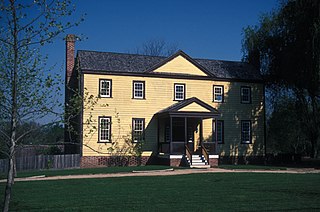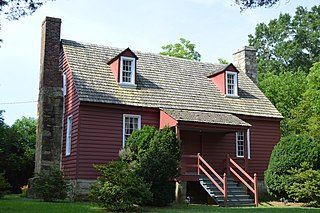
McDowell County is a county located in the U.S. state of North Carolina. As of the 2020 census, the population was 44,578. Its county seat is Marion.

Burke County is a county located in the U.S. state of North Carolina. As of the 2020 census, its population was 87,570. Its county seat is Morganton.

Marion is a city in and the county seat of McDowell County, North Carolina, United States. Founded in 1844, the city was named in honor of Brigadier General Francis Marion, the American Revolutionary War Hero whose talent in guerrilla warfare earned him the name "Swamp Fox". Marion's Main Street Historic District is listed on the National Register of Historic Places. The population was 7,717 at the 2020 Census.

Kernersville is a town in Forsyth County and the largest suburb of Winston-Salem. The town is located in the U.S. state of North Carolina. A small portion of the town is also in Guilford County. The population was 26,481 at the 2020 census, up from 23,123 in 2010. Kernersville is located at the center of the Piedmont Triad metropolitan area, between Greensboro to the east, High Point to the south, and Winston-Salem to the west. Some of the farmland surrounding the town has been sold and turned into large middle-to-upper-class housing developments.

This is a list of structures, sites, districts, and objects on the National Register of Historic Places in North Carolina:
Tyro is an unincorporated community and census-designated place (CDP) located 7 miles (11 km) west of Lexington and 24 miles (39 km) south of Winston-Salem in Davidson County, North Carolina, United States. As of the 2020 census, the community had a population of 8,926.

The Linville Gorge Wilderness is the third largest wilderness area in North Carolina and one of only two wilderness gorges in the Southern United States. Maintained by the United States Forest Service, it comprises 11,786 acres (47.7 km2) around the Linville River, and is situated inside the Pisgah National Forest. The river is approximately 1,400 feet below the ridge, thus hiking in and out of the Gorge is challenging and enjoyable for those who like serious hiking. The plant and animal community is extremely diverse, with a dense hardwood/pine forest and a wide variety of smaller trees and other plants as well as bear, fox, raccoon, trout, grouse, wild turkey, vultures, owls, hawks, copperheads, and timber rattlesnakes.

The Linville River is a river in western North Carolina, United States. The river begins in the slopes of Peak Mountain, Sugar Mountain and Flattop Mountain, in the Linville Gap area. As it goes south through Avery County, it passes through the communities of Grandfather, Linville, Pineola, Crossnore and finally at Linville Falls. After entering Burke County at the community of Linville Falls, the river becomes the centerpiece of the Linville Falls and the Linville Gorge, an area referred to as "the Grand Canyon of North Carolina." After approximately 30 miles (48 km), the river ends at Lake James and the Catawba River; the original confluence with the Catawba River has been flooded by the creation of the reservoir in 1923.

Linville is an unincorporated community and census-designated place (CDP) in Avery County, North Carolina, United States. It was first listed as a CDP in the 2020 census with a population of 283. Centered just south of US 221 and NC 105, the community is known as a summer mountain resort and host of the Grandfather Mountain Highland Games, the largest modern Highland games events in North Carolina.

Union Tavern is a historic tavern and workshop on Broad Street in Milton, North Carolina. It is a rare example of a well-preserved early 19th-century Federal period tavern, and is further notable as the workshop of Thomas Day, a free person of color who was one of North Carolina's leading cabinetmakers. The building was designated a National Historic Landmark in 1975. It is located in the Milton Historic District.

Falls, is an unincorporated community in Wake County, North Carolina, United States, situated on Old Falls of Neuse Road, between Raleigh and Wake Forest, near the Wakefield Plantation development. Falls Dam, on the Neuse River, is within the community.

Linville Falls is an unincorporated community at the junction of Avery, Burke, and McDowell counties in the U.S. state of North Carolina. The community is named after Linville Falls, a nearby waterfall in the Linville Gorge Wilderness.

Brooklandville House, or the Valley Inn, is a historic restaurant and tavern building, and a former inn, located in Brooklandville, Baltimore County, Maryland. It is a 2+1⁄2-story stone structure facing the former railroad and dating from about 1832. It is associated with the Baltimore and Susquehanna Railroad, which crossed the property just to the south.
Altamont is an unincorporated community in Avery County, North Carolina, United States. The community is located along US 221/NC 194, between the town of Crossnore and the community of Linville Falls. Altamont translates to "High Mountain."

Linville is a Census-designated place located in Rockingham County, in the U.S. state of Virginia. It is located 6 miles north of Harrisonburg, Virginia. It is for the first time listed as CDP for the United States Census 2020. It contains the Linville United Church of Christ.

Linville Historic District is a historic school campus and national historic district located at Linville, Avery County, North Carolina. It encompasses 96 contributing buildings and 4 contributing structures in the historic core of Linville. The buildings date between about 1892 and 1940, and include shingle-or chestnut bark-covered resort buildings and the second generation of houses flanking the first and eighteenth fairways of the golf course. Notable buildings include the Hemlock Cottage, Dormiecroft, "Honeymoon" Cottage, Presbyterian Church, The Studio, the VanLandingham House, and All Saints Episcopal Church.

The Eagle Tavern is a historic tavern built in the 1790s in Halifax, Halifax County, North Carolina. The tavern served as an overnight stop on February 27, 1825 for the official traveling party during the Visit of the Marquis de Lafayette to the United States. The tavern is demarcated as "E-68" on the North Carolina Highway Historical Marker Program. It is a two-story, pedimented, "T"-shaped tripartite frame building. It was moved to its present site in the 1840s.

Franklin-Penland House, also known as Theodore C. Franklin House, Stokes Penland House, and Linville Falls Post Office, is a historic home located at Linville Falls, Burke County, North Carolina. It was built about 1883, and is a two-story, three-bay, frame I-house with a two-story rear ell. It features a full-width, attached two-tiered shed roof porch added about 1915. Also on the property is the former U.S. Post Office, Linville Falls, N.C., building. The one-room front gable frame building was built in 1907 and housed the Linville Falls post office until 1925.

Person's Ordinary is a historic inn and tavern located at Littleton, Halifax County, North Carolina. It dates to the mid- to late-18th century, and is a 1 1/2-story frame dwelling, three bays wide and two deep, with a massive exterior stone chimney at each end. It rests on a stone cellar, and has a modified Quaker plan. The building housed an inn and tavern for stagecoach travelers into the 1830s and is associated with Thomas Person, one of the state's most important political leaders from 1760 to 1790.

Falls of the Neuse Manufacturing Company, also known as the Manteo Manufacturing Company and Forest Manufacturing Company, is a historic paper mill complex located at Falls, Wake County, North Carolina. The main mill building was built from1854–1855, and is a three-story, quarried granite block building measuring 195 feet long and 54 feet wide. Located on the property is the stone mill dam, measuring about 400 feet wide and roughly 6 feet tall, and the one-story picker room, measuring 53 feet square. The mill operated as a paper mill until 1896, and later housed a cotton mill and warehouse.






















